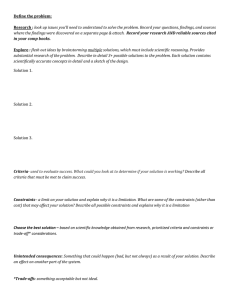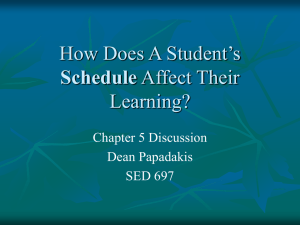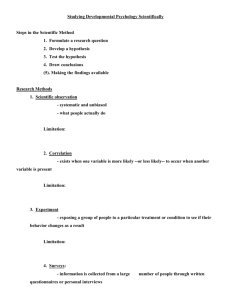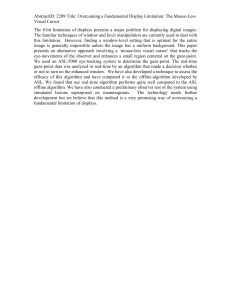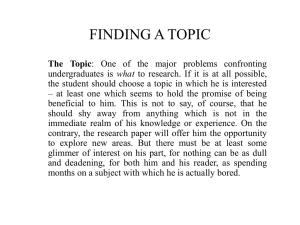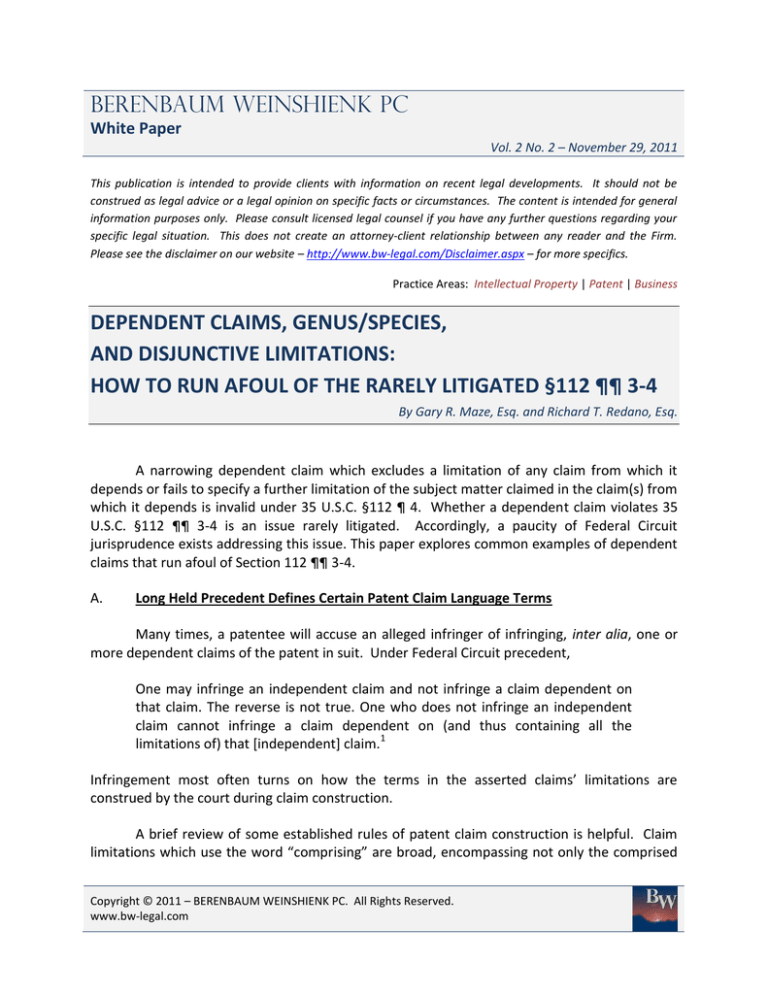
Berenbaum Weinshienk pc
White Paper
Vol. 2 No. 2 – November 29, 2011
This publication is intended to provide clients with information on recent legal developments. It should not be
construed as legal advice or a legal opinion on specific facts or circumstances. The content is intended for general
information purposes only. Please consult licensed legal counsel if you have any further questions regarding your
specific legal situation. This does not create an attorney-client relationship between any reader and the Firm.
Please see the disclaimer on our website – http://www.bw-legal.com/Disclaimer.aspx – for more specifics.
Practice Areas: Intellectual Property | Patent | Business
DEPENDENT CLAIMS, GENUS/SPECIES,
AND DISJUNCTIVE LIMITATIONS:
HOW TO RUN AFOUL OF THE RARELY LITIGATED §112 ¶¶ 3-4
By Gary R. Maze, Esq. and Richard T. Redano, Esq.
A narrowing dependent claim which excludes a limitation of any claim from which it
depends or fails to specify a further limitation of the subject matter claimed in the claim(s) from
which it depends is invalid under 35 U.S.C. §112 ¶ 4. Whether a dependent claim violates 35
U.S.C. §112 ¶¶ 3-4 is an issue rarely litigated. Accordingly, a paucity of Federal Circuit
jurisprudence exists addressing this issue. This paper explores common examples of dependent
claims that run afoul of Section 112 ¶¶ 3-4.
A.
Long Held Precedent Defines Certain Patent Claim Language Terms
Many times, a patentee will accuse an alleged infringer of infringing, inter alia, one or
more dependent claims of the patent in suit. Under Federal Circuit precedent,
One may infringe an independent claim and not infringe a claim dependent on
that claim. The reverse is not true. One who does not infringe an independent
claim cannot infringe a claim dependent on (and thus containing all the
limitations of) that [independent] claim.1
Infringement most often turns on how the terms in the asserted claims’ limitations are
construed by the court during claim construction.
A brief review of some established rules of patent claim construction is helpful. Claim
limitations which use the word “comprising” are broad, encompassing not only the comprised
Copyright © 2011 – BERENBAUM WEINSHIENK PC. All Rights Reserved.
www.bw-legal.com
Berenbaum Weinshienk PC
White Paper
The America Invents Act: Much Ado About Very Little
element but other elements as well.2 The words “having” and “include” mean the same thing as
“comprise.”3
Claims reciting limitation elements in the disjunctive are operable as written for any of
the limitations, i.e. with the disjunctive limitation elements taken either singly or in
combination.4 Additionally, a limitation comprising a genus is understood to comprise each
species of that genus in the alternative.5
Thus, a claim reciting “a widget comprising A and B,” for example, would be infringed by
any widget containing A and B, even though C, D, and/or E might be also present.6 Similarly, a
claim reciting “a widget comprising A or B” would be infringed by any widget containing either
A or B or both A and B, even if C, D, and/or E might also be present.7 A limitation comprising
the genus “a halogen gas” would be understood to comprise each of the separate species gases
of fluorine, chlorine, bromine, iodine, and/or astatine.
In contrast, “closed” transition phrases such as “consisting of” are understood to
exclude any elements, steps, or ingredients not specified in the claim.8 The word “is,” when
used in claim language to further define a preexisting limitation element, narrows that
limitation, e.g. the widget of Claim X where the linkage “is” a chain limits “linkage” to “chains,”
thus excluding any other kind of linkage.9
A question that has arisen, although not often, is whether a second claim which
depends from a first claim is valid under 35 U.S.C. §112 ¶¶ 3-4 if all that the second claim does
is limit itself to one of the first claim’s enumerated, disjunctive alternatives, species, or
components.10 A further question that has not arisen at the Federal Circuit level is whether a
second claim that seems to limit a limitation in a claim from which depends by using “is” to
equate the first claim’s limitation to a single instance is also valid under 35 U.S.C. §112 ¶¶ 3-4.
B.
Dependent Claims Are Constrained Under 35 U.S.C. §112 ¶¶ 3-4
Under 35 U.S.C. §112, ¶¶ 3 and 4, a claim:
may be written in independent or, if the nature of the case admits, in dependent
or multiple dependent form.11 Subject to the following paragraph, a claim in
dependent form shall contain a reference to a claim previously set forth and
then specify a further limitation of the subject matter claimed. A claim in
dependent form shall be construed to incorporate by reference all the
limitations of the claim to which it refers.12
A claim’s status as dependent or independent “depends on the substance of the claim in light of
the language of § 112, ¶ 4, and not the form alone.”13 Accordingly, a valid dependent claim
Copyright © 2011 – BERENBAUM WEINSHIENK PC. All Rights Reserved.
www.bw-legal.com
Page 2 of 10
Berenbaum Weinshienk PC
White Paper
The America Invents Act: Much Ado About Very Little
possesses two major characteristics: (1) it incorporates all of the limitations of the claim(s) from
which it depends and, additionally, (2) must specify a further limitation of the subject matter
claimed while still incorporating all of those prior limitations. Thus, to establish whether a claim
properly is dependent upon another claim, a court must first determine whether the new claim
both (1) refers to an earlier claim and (2) further limits that earlier claim.14 If a dependent claim
does not specify a further limitation of the claimed subject matter, the claim may be invalid for
failure to comply with § 112 ¶ 3.
When determining if a claim is a proper dependent claim, a second consideration is the
doctrine of “claim differentiation.” Although a presumption exists that an independent claim
should not be construed as requiring a limitation added by a dependent claim, 15 under § 112 ¶
4, any term recited in a claim from which another claim depends, directly or indirectly, is
incorporated into every dependent claim which depends from that first claim. 16 Because the
statute “stresses that a dependent claim must add a limitation to those recited in the
independent claim,” reading an additional limitation from a dependent claim back into an
independent claim “would not only make that additional limitation superfluous, it might render
the dependent claim invalid.”17 The doctrine of claim differentiation incorporates the Federal
Circuit’s warning that, “[t]he dependent claim tail cannot wag the independent claim dog.”18
A violation of § 112, ¶ 4 renders a patent claim invalid just as do violations of other
paragraphs of § 112.19 For example, if independent claim 1 recites a “general purpose
computer system,” none of its dependent claims are free of claim 1’s limitation requiring
incorporation of a general purpose computer system.20 With respect to method claims, a
dependent claim must also include all the steps of the claim from which it depends.21
C.
Dependent Claims Must Include A “Further Limitation”
A potential § 112, ¶ 4 issue arises when a dependent claim seeks to exclude or
otherwise fails to incorporate all of the limitations of limitations present in the claim(s) from
which the dependent claim depends. In view of these requirements, trouble for the patentee
may arise when an independent claim, or any other claim from which further claims depend,
states a limitation as a genus, e.g. “metal” or “halogen gas,” or as an enumerated set of
disjunctively joined alternatives, e.g. a limitation comprising an “A” or a “B” as the following
examples demonstrate.22
Consider the following claims, which are genus-species types, commonly found in the
chemical arts:
Claim 1.
Chemical 1, chemical 2, or pharmaceutically acceptable salts
thereof.
Copyright © 2011 – BERENBAUM WEINSHIENK PC. All Rights Reserved.
www.bw-legal.com
Page 3 of 10
Berenbaum Weinshienk PC
White Paper
The America Invents Act: Much Ado About Very Little
Claim 2.
A compound of claim 1 which is chemical 1.
Claim 3.
The hemicalcium salt of the compound of claim 2.
Claim 2 is facially narrower than Claim 1 from which it expressly depends; however, by
excluding chemical 2 and pharmaceutically acceptable salts of chemical 1 or chemical 2, Claim 2
violates 35 U.S.C. §112 ¶ 4 which requires a dependent claim to incorporate all limitations of
the claims from which it depends.23 Additionally, although appearing narrower than Claim 2,
Claim 3 fails to “specify a further limitation of the subject matter” of Claim 2 because it is
outside the scope of Claim 2 and is thus invalid under 35 U.S.C. §112 ¶ 4. 24 In this example,
Claim 2 could have been written “A compound of claim 1 which comprises chemical 1.” This,
arguably, conforms with the requirements of 35 U.S.C. §112 ¶ 4 because Claim 1 comprises
acceptable salts of chemical 1 and Claim 2, if rewritten, would require chemical 1 itself and
could incorporate compounds that include chemical 1 and its acceptable salts.
Apparatus claims may claim limitations in the disjunctive.
example:
Consider the following
Claim 4.
An apparatus, comprising a first widget which is an “A” or a “B.”
Claim 5.
The apparatus of Claim 4, wherein the first widget is “A.”
Claim 5, which depends from Claim 4, excludes the first widget being “B” by requiring that the
first widget is limited to being only “A.” Thus, Claim 5 is invalid because, by excluding first
widget being “B,” it does not incorporate all the limitations of Claim 4. 25 As above, Claim 5
could have been written as “wherein the first widget comprises “A” to conform with 35 U.S.C.
§112 ¶ 4 by narrowing Claim 4 to require the apparatus include “A” and optionally also include
“B.”
A dependent claim may also improperly attempt to exclude prior limitations which do
not use a disjunctive connector. Consider the following apparatus claim example:
Claim 6.
A shredder comprising at least two touch switches.
Claim 7.
A shredder as in Claim 6, comprising a single touch switch
Per 35 U.S.C. §112 ¶4, dependent Claim 7 must incorporate all of the limitations of Claim 6.
Accordingly, Claim 7 violates 35 U.S.C. §112 ¶4 because it does not incorporate all of the
Copyright © 2011 – BERENBAUM WEINSHIENK PC. All Rights Reserved.
www.bw-legal.com
Page 4 of 10
Berenbaum Weinshienk PC
White Paper
The America Invents Act: Much Ado About Very Little
limitations of Claim 6 to which it refers, i.e. it attempts to limit two or more touch switches to a
single touch switch.26
D.
A Careful Review Of Dependent Claims Can Reveal Fatal Flaws
A relevant question is whether claims such as those in the above examples are invalid
under 35 U.S.C. §112 ¶ 4 for failing to include all the limitations of the claim(s) to which they
refer. Although there are few cases directly on point, the answer to these questions is yes. For
example, in a recent district court case the claim at issue read “A stable tablet comprising on a
weight percentage basis … from about 5% to about 15% of a single agent which is both binder
and disintegrant….”27 The defendant argued that the Court should read “is” in this “which is
both binder and disintegrant” clause as connoting “equality” or “consists of,” such that the
single agent would be limited to those two functionalities.28 The plaintiff urged a meaning of
“including but not limited to.”29 The Court agreed with the defendant and held that “is” meant
“equal and limited to.”30 The Court held that to do otherwise would render the phrase
redundant and superfluous, “since, absent the single agent limitation, a multi-functional
excipient already would have been covered by reading the binder and disintegrant limitations
as allowing one excipient to satisfy both functions.”31
Accordingly, in context “is” will likely be construed as “equal and limited to.” Thus, if an
independent claim contains a limitation that an element “is a metal” and a dependent claim
reads “the metal is aluminum,” the dependent claim is invalid under §112 ¶¶3-4 because the
dependent claim no longer includes non-aluminum metal species, such as copper or iron.32
A claim may be invalid under Section 112 ¶4 without exalting form over substance.33
For example, a dependent claim runs afoul of 35 U.S.C. §112 ¶4 by attempting to further limit a
broader choice present in a claim to which if refers by using the word “is.” If the independent
claim claims “a metal,” e.g., a dependent claim that claims “where the metal is copper” is
invalid under 35 U.S.C. §112 ¶ 4. Contrarily, the dependent claim would not run afoul of
Section 112 ¶ 4 if its limitation was “where the metal comprises copper.” The distinction
between “is,” meaning a limiting equating, and “comprise,” which is not so limiting, is not
exaltation of form over substance.
Similarly, in view of 35 U.S.C. §112 ¶ 3-4, if a limitation in an independent claim contains
a choice, e.g. either “a” or “b,” or a genus, e.g. noble gas, and a dependent claim limits the
choice to one of the enumerated options or to a species, the dependent claim does not contain
all the limitations of the claim from which it depends and is invalid. Thus, a dependent claim
Copyright © 2011 – BERENBAUM WEINSHIENK PC. All Rights Reserved.
www.bw-legal.com
Page 5 of 10
Berenbaum Weinshienk PC
White Paper
The America Invents Act: Much Ado About Very Little
which limits a genus to a species by use of “is” instead of “comprises” is invalid under 35 U.S.C.
§112 ¶ 4.34
Switching focus to the statutory requirement that a dependent claim must add a
limitation to the claim from which it depends, per § 112, ¶ 4, suppose the independent claim
requires a widget comprising copper or iron or aluminum and the dependent claim states that
the widget “is” iron. Arguably, the dependent claim is invalid under §112 ¶ 4 because the
independent claim already has the limitation that the widget could be iron, alone, and thus the
dependent claim specifies no further limitation. Moreover, by using “is” rather than
“comprise,” the dependent claim eliminates, rather than includes, some of the limitations of
the independent claim to which it refers. However, case law suggests that this dependent claim
is valid, i.e. a disjunctive independent claim limitation is narrowed in a dependent claim where
the dependent claim is limited to one of the proposed disjunctive choices using “is.” 35 This
precise issue has not yet been litigated.36
E.
Recent Federal Circuit Cases
In American Piledriving Equipment, Inc. v. Geoquip, Inc., an independent claim required
“an eccentric weight portion connected to said cylindrical gear portion” and a dependent claim
required “said eccentric weight portion is integral with said cylindrical gear portion.”37 The
defendant contended that because the independent claim encompassed a two-piece
counterweight, the dependent claim must also encompass a two-piece counterweight and,
accordingly, “integral” cannot mean “formed or cast of one piece” because that would require
the counterweight described in the dependent claim to be both “two piece” and “one piece” at
the same time. Citing 35 U.S.C. §112, ¶ 4, the Federal Circuit disagreed, holding that the
independent claim’s limitation encompasses both one-piece and two-piece counterweights that
are “joined together,” noting “where, as here, the claims describe the same relationship using
different terms, the assumption is that the term in the dependent claim has a narrower
scope.”38 Thus, although the dependent claim’s limitation used “is,” an integral connection is
still a connection and, thus, a narrowing limitation.
In Reckitt Benckiser Inc. v. Watson Laboratories, Inc., the independent claim in question
read “A modified release product having two portions, wherein a first portion comprises a first
quantity of guaifenesin … and a second portion comprises a second quantity of guaifenesin ….”
The dependent claim, not at issue, read “…wherein said first and second portions each
comprise abutting substantially planar layers which form a bilayer tablet.” A Federal Circuit
panel, citing 35 U.S.C §112 ¶ 4 and the doctrine of claim differentiation, held that the district
Copyright © 2011 – BERENBAUM WEINSHIENK PC. All Rights Reserved.
www.bw-legal.com
Page 6 of 10
Berenbaum Weinshienk PC
White Paper
The America Invents Act: Much Ado About Very Little
court’s construction of the independent claim as encompassing three separate embodiments of
two-portion tablets and capsules allowed the dependent claim directed only to one particular
type of bilayer tablet.39 What the Federal Circuit did not address, however, was whether the
dependent claim, which was not at issue, violated § 112, ¶ 4. This dependent claim used
“comprise” as opposed to “is.” Thus, the dependent claim narrowed the independent claim by
requiring that the product have two portions, a first portion which comprised a first quantity of
guaifenesin and a second portion which comprised a second quantity of guaifenesin, where
each such first and second portions of each such embodiment further also have abutting
substantially planar layers which form a bilayer tablet.
CONCLUSION
It is important for patent prosecutors and patent litigators not to overlook the
requirements of Section §112 third and fourth paragraphs in their analysis. Patent prosecutors
should avoid prosecuting dependent claims exclude limitations of the claims from which they
depend. Patent prosecutors should also carefully use “is,” and contemplate using “comprise”
instead of “is.”
Litigators defending against allegations of infringement of dependent claims should
analyze the dependent claims under Section 112 ¶¶3-4, especially where the prior claim has
disjunctive terms. Asserted dependent claims which do no more than restate one of several
enumerated limitation choices, inclusion of any one of which would result in infringement,
without specifying a further limitation of the subject matter should be argued to be invalid
under Section 112 ¶¶3-4.
About the Author
Gary R. Maze, Esq. has been practicing intellectual property law since 1995. A registered patent
attorney, Mr. Maze's practice includes helping companies and individuals with patent,
trademark, copyright, trade secret, and related issues. He has represented plaintiffs and
defendants in intellectual property and general commercial litigation and helps companies and
individuals understand and plan for patent, trademark, copyright, and trade secret issues. Mr.
Maze’s profile can be found on the firm website:
http://www.bwlegal.com/People/Profile.aspx?id=63.
Copyright © 2011 – BERENBAUM WEINSHIENK PC. All Rights Reserved.
www.bw-legal.com
Page 7 of 10
Berenbaum Weinshienk PC
White Paper
The America Invents Act: Much Ado About Very Little
1
Monsanto Company v. Syngenta Seeds, Inc., 530 F.3d 1352, 1359 (Fed. Cir. 2007), citing Wahpeton Canvas
Co., Inc. v. Frontier, Inc., 870 F.2d 1546, 1552 (Fed. Cir. 1989) (the “Wahpeton rule”).
2
AFG Industries, Inc. v. Cardinal IG Co., Inc., 239 F.3d 1239, 1244-45 (Fed. Cir. 2001).
3
See Hewlett-Packard Co. v. Repeat-O-Type Stencil Mfg. Corp., Inc., 123 F.3d 1445, 1451 (Fed.Cir. 1997)
(“The claim term ‘including’ is synonymous with ‘comprising,’ thereby permitting the inclusion of unnamed
components.”).
4
See, e.g., Housey Pharmaceuticals, Inc. v. Astrazeneca UK Ltd., 366 F.3d 1348 (Fed. Cir. 2004)(upholding
disjunctive claim construction as being either a first option or a second option); Depomed, Inc. v. Ivax Corp., 532
F.Supp.2d 1170, 1181 (N.D.Cal. 2007). These types of claims should be distinguished over Markush claims, i.e. a
claim limitation offering a closed in set of possible elements. 491 F.Supp.2d 571. Thus, where an independent
claim recites “a widget selected from the group of widgets comprising A, B, and C” a claim depending therefrom
would be valid if it limits the widget to A.
5
See, e.g., Intervet Inc. v. Merial Ltd., 617 F.3d 1282, 1287 (Fed. Cir. 2010)(“Claims properly directed to a
genus may be adequately supported by the patent disclosure if a sufficient number of species is disclosed so as to
properly identify the scope of the genus.”)
6
Amgen Inc. v. Hoechst Marion Roussel, Inc., 314 F.3d 1313,1345 (Fed. Cir. 2003).
7
See Therasense, Inc. v. Becton, Dickinson and Co., 593 F.3d 1289, 1315 (Fed. Cir. 2010)(claim comprising
limitation which “comprises ‘a’ or ‘b’” can be understood to mean that “a” and “b” are alternatives rather than
overlapping categories, i.e. the limitation is either “a” or optionally “b.”).
8
CIAS, Inc. v. Alliance Gaming Corp., 504 F.3d 1356, 1360–61 (Fed. Cir. 2007) (stating
that “‘comprising’ is well understood to mean ‘including but not limited to,’” and that
“‘consisting of’ is close-ended and conveys limitation and exclusion”); AFG Industries, Inc. v.
Cardinal IG Co., Inc., 239 F.3d 1239, 1244 (Fed. Cir. 2001); but cf. Conoco, Inc. v. Energy &
Envtl. Int’l, L.C., 460 F.3d 1349, 1360 (Fed. Cir. 2006) (noting that, despite the restrictive nature
of “consisting of,” use of this phrase “does not exclude additional components or steps that are
unrelated to the invention”); Norian Corp. v. Stryker Corp., 363 F.3d 1321, 1331 (Fed. Cir.2004)
(“‘Consisting of’ is a term of patent convention meaning that the claimed invention contains only
what is expressly set forth in the claim. However, while ‘consisting of’ limits the claimed
invention, it does not limit aspects unrelated to the invention.”). Thus, if a limitation is related to
the invention, “consisting of “ is “close-ended and conveys limitation and exclusion.” CIAS, Inc.,
504 F.3d at 1360–61.
9
See Bristol-Myers Squibb v. Andrx Pharmaceuticals, 343 F. Supp. 2d 1124, 1139(S.D.Fla. 2004)(“there is no
reason to believe that, in that claim limitation, any word more precise than ‘is’ could or should have been used,
and the meaning of ‘is’ must be viewed in the context of the phrase and the claim”), citing Brookhill-Wilk 1, LLC v.
Intuitive Surgical, Inc., 334 F.3d 1294, 1300 (Fed.Cir. 2003).
10
In this context, “component” would be, e.g., “bronze” where the limitation element is “metal.”
11
35 U.S.C. §112, ¶ 3.
12
35 U.S.C. §112, ¶4 (emphasis added).
13
Monsanto Co., 530 F.3d at 1357, citing 35 U.S.C § 112, ¶ 4.
14
Pfizer, Inc. v. Ranbaxy Laboratories Ltd., 457 F. 3d 1284, 1292 (Fed.Cir. 2006).
15
See Nazomi Commc’ns, Inc. v. Arm Holdings, PLC., 403 F.3d 1364, 1370 (Fed. Cir. 2005) (“[C]laim
differentiation ‘normally means that limitations stated in dependent claims are not to be read into the
Copyright © 2011 – BERENBAUM WEINSHIENK PC. All Rights Reserved.
www.bw-legal.com
Page 8 of 10
Berenbaum Weinshienk PC
White Paper
The America Invents Act: Much Ado About Very Little
independent claim from which they depend.’” (quoting Karlin Techs., Inc. v. Surgical Dynamics, Inc., 177 F.3d 968,
971-72 (Fed. Cir. 1999))).
16
See Hutchins v. Zoll Medical Corp., 492 F.3d 1377, 1382 (Fed. Cir. 2007), citing 35 U.S.C. § 112 ¶ 4 (“A
claim in dependent form shall be construed to incorporate by reference all the limitations of the claim to which it
refers.”).
17
Curtiss-Wright Flow Control Corp. v. Velan, Inc., 438 F.3d 1374,1380 (Fed. Cir. 2006).
18
North Am. Vaccine, Inc. v. Am. Cyanamid Co., 7 F.3d 1571, 1577 (Fed.Cir.1993), cert. denied, 511 U.S. 1069
(1994).
19
Curtiss-Wright Flow Control Corp., 438 F.3d at 1380. Although “dependent or multiple dependent claims
shall be presumed valid even though dependent on an invalid claim,” 35 U.S.C. § 282, in most situations the
converse is not true; a dependent claim cannot be invalid as obvious or anticipated by certain prior art while the
(broader) claim from which it depends is valid in view of the same prior art. See 35 U.S.C. § 112, ¶ 4 (“[A] claim in
dependent form shall contain reference to a claim previously set forth and then specify a further limitation of the
subject matter claimed. A claim in dependent form shall be construed to incorporate by reference all the limitation
of the claim to which it refers.”); Ormco Corp. v. Align Tech., Inc., 498 F.3d 1307, 1319 (Fed.Cir.2007) (“Because
claims 10 and 17 were found to have been obvious, the broader claims 1 and 11 must also have been obvious.”);
see also L & W, Inc. v. Shertech, Inc., 471 F.3d 1311, 1318 (Fed.Cir.2006) (acknowledging inconsistency between
verdict that independent claim 7 was valid but dependent claim 10 invalid) (holding that both parties waived
objections to the inconsistency under Sixth Circuit waiver law); Intermatic Inc. v. Lamson & Sessions Co., 273 F.3d
1355, 1368 (Fed.Cir.2001) (acknowledging inconsistency of verdicts that dependent claims were not invalid for
obviousness where the jury had found the independent claims nonobvious) (affirming district court’s JMOL
resolving inconsistent verdicts).
20
Id.
21
See Monsanto Co., 530 F.3d at 1357 .
22
The authors note that the use of disjunctive elements in a claim limitation may create indefiniteness and
lead to problems under 35 U.S.C. §112 ¶2; however, that is an area for discussion at a later time.
23
See, e.g., Pfizer, 457 F. 3d at 1292 (although the Federal Circuit did not expressly rule on this issue); see
also Monsanto Co., 503 F.3d at 1357-58 (“To establish whether a claim is dependent upon another, this court
examines if the new claim both refers to an earlier claim and further limits that referent. 35 U.S.C § 112, ¶ 4 (‘[A]
claim in dependent form shall contain a reference to a claim previously set forth and then specify a further
limitation of the subject matter claimed. A claim in dependent form shall be construed to incorporate by reference
all the limitations of the claim to which it refers.’). A claim’s status as dependent or independent depends on the
substance of the claim in light of the language of § 112, ¶ 4, and not the form alone.”).
24
Pfizer, 457 F. 3d at 1292 (holding the claim invalid and noting “Indeed, claim 6 could have been properly
drafted either as dependent from claim 1 or as an independent claim—i.e., ‘the hemicalcium salt of atorvastatin
acid.’ But, we ‘should not rewrite claims to preserve validity.’”). The Federal Circuit did not address the validity of
Claim 5.
25
Id.
26
Because Claim 1 requires at least two switches, the single switch of dependent Claim 2 was construed as
an additional third switch to the two switches of Claim 1 because “[a]ny other result would amount to redrafting
[the] claims, a power this court lacks. Zircon Corporation v. The Stanley Works, 713 F. Supp. 2d 881,892-893
(N.D.Cal. 2010), quoting Michilin Prosperity Co. v. Fellowes Mfg. Co., 450 F.Supp. 2d 35 (D.D.C. 2006); see also
Michilin Prosperity Co. v. Fellowes Mfg. Co., 422 F.Supp. 2d 86,90 (D.D.C. 2006) (court refused to “correct” a
dependent claim which attempted to claim a one-switch/one-bin embodiment where the independent claim
required two switches). Note that the phrase “a single touch switch” lacks antecedent basis because of its use of
the indefinite article “a,” something on which the Zircon court did not comment. Claim 7 cannot be rewritten to
be valid.
27
Bristol-Myers Squibb Company, 343 F. Supp. 2d at 1134.
Copyright © 2011 – BERENBAUM WEINSHIENK PC. All Rights Reserved.
www.bw-legal.com
Page 9 of 10
Berenbaum Weinshienk PC
White Paper
The America Invents Act: Much Ado About Very Little
28
Id., at 1135.
Id., at 1139.
30
Id., at 1138.
31
Id., at 1139.
32
Curtiss-Wright Flow Control Corp., 438 F.3d at 1380.
33
See Id.
34
See Hutchins, 492 F.3d at 1382; see also AK Steel Corp., 344 F. 3d at 1242.
35
Pfizer, Inc. v. Ranbaxy Laboratories Ltd., 405 F.Supp.2d 495,508 (D.De.2005), overturned in relevant part,
457 F. 3d 1284, 1292 (Fed.Cir. 2006).
36
As explained in prior portions of this paper, the dependent claim’s exclusion of the independent claim’s
limitation allowing copper or aluminum, in addition to iron, results in its invalidity for failure to incorporate by
reference all the limitations of the claim to which it refers.
37
American Piledriving Equipment, Inc. v. Geoquip, Inc., 637 F.3d 1324,1330 (Fed. Cir. 2011)
38
Id., at 1335.
39
Reckitt Benckiser Inc. v. Watson Laboratories, Inc., 2011 U.S. App. LEXIS 13980 at *16-17 (Fed. Cir. July 7,
2011)(unpublished nonprecedential opinion).
29
Copyright © 2011 – BERENBAUM WEINSHIENK PC. All Rights Reserved.
www.bw-legal.com
Page 10 of 10

